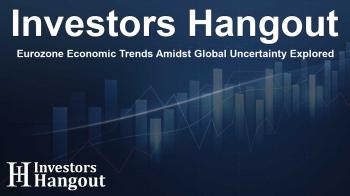Eurozone Economic Trends Amidst Global Uncertainty Explored

Eurozone Economic Trends in an Era of Uncertainty
The Eurozone's economic landscape is currently marked by fluctuations, with ongoing developments in global trade impacting its stability. Despite some prior optimism due to strong exports in early quarters, the region is now witnessing a shift that reveals a weakening underlying trend.
Recent Economic Performance Highlights
Following a surge in growth attributed to US front-loading, the Eurozone has now encountered challenges that have led to a stagnating economy. In the first quarter, growth reached a notable 0.6%, sustained primarily by a strong performance in the pharmaceutical sector driven by heightened exports. However, subsequent industrial data has illustrated a decline in production and exports, indicating a retraction in growth momentum.
April saw industrial production decline by 2.4%, while exports faced an even steeper drop of 8.2%. Such figures cast doubt on the durability of the previously observed growth, suggesting that the benefits from US trade adjustments are waning. Furthermore, the domestic landscape is rife with uncertainty, negatively affecting consumer confidence and spending.
Deep Dive into Service Sector Challenges
As the second quarter progresses, troubling signs in the service sector have become apparent. Data reveals a month-on-month decrease in services production of 0.3% in April, coupled with a further retail sales decline of 0.7% in May. While seasonal variations could influence these figures, a persistent weakness in services signals deeper issues within the Eurozone economy.
Consumer Sentiment and Its Impact on Demand
The mindset of both consumers and businesses has become cautious, elevating concerns regarding domestic demand. For the upcoming third quarter, predictions indicate stagnation compared to previous growth. This apprehension is exacerbated by ongoing trade tensions, which contribute to a climate of unpredictability. Although we may not see a dramatic escalation in trade conflicts, the established uncertainties are expected to linger.
This persistent environment of doubt is impacting economic activities significantly, evident in the ongoing lackluster performance of the service sector. Despite favorable wage growth and low employment rates, consumer spending remains tepid, primarily due to high household savings rates curtailing immediate consumption recovery.
Inflation Trends and ECB Responses
The backdrop of easing inflationary pressures raises questions about the European Central Bank's future actions. As domestic demand continues to wane, lower energy prices, and a stronger euro contribute to inflation metrics falling below the ECB's target of 2%. Forecasts suggest that a rate cut is imminent, with expectations for a reduction in September before the central bank takes a potentially prolonged pause.
While the current deposit rate stands at 2%, any further reduction appears unnecessary given upcoming public investments scheduled to stimulate the economy. The medium-term outlook may shift back towards stability as these investments come into play, offering a pathway back to gradual growth.
Conclusion: A Path Forward?
As the Eurozone navigates through this time of economic turbulence, the interplay between external pressures and internal market confidence will be pivotal. The hope lies in effective public investments being realized to rejuvenate the economy, gradually fostering a more optimistic economic scenario.
Frequently Asked Questions
What factors are contributing to the Eurozone's economic slowdown?
The slowdown is primarily due to waning exports, declining industrial production, and subdued domestic demand influenced by consumer uncertainty.
How has recent trade tension affected the Eurozone economy?
Ongoing trade tensions have heightened uncertainty, affecting consumer confidence and leading to a decline in both spending and growth.
What is the outlook for the European Central Bank's interest rates?
There is an expectation of a rate cut in September, followed by a pause, as inflation continues to undershoot the ECB’s target.
What role does consumer sentiment play in the Eurozone economy?
Consumer sentiment is pivotal; fearful consumers tend to save rather than spend, thus impacting overall demand and growth negatively.
How can public investment influence the Eurozone recovery?
Public investments can stimulate economic activity, potentially leading to improved growth and consumer confidence as the funds begin to circulate in the economy.
About The Author
Contact Lucas Young privately here. Or send an email with ATTN: Lucas Young as the subject to contact@investorshangout.com.
About Investors Hangout
Investors Hangout is a leading online stock forum for financial discussion and learning, offering a wide range of free tools and resources. It draws in traders of all levels, who exchange market knowledge, investigate trading tactics, and keep an eye on industry developments in real time. Featuring financial articles, stock message boards, quotes, charts, company profiles, and live news updates. Through cooperative learning and a wealth of informational resources, it helps users from novices creating their first portfolios to experts honing their techniques. Join Investors Hangout today: https://investorshangout.com/
The content of this article is based on factual, publicly available information and does not represent legal, financial, or investment advice. Investors Hangout does not offer financial advice, and the author is not a licensed financial advisor. Consult a qualified advisor before making any financial or investment decisions based on this article. This article should not be considered advice to purchase, sell, or hold any securities or other investments. If any of the material provided here is inaccurate, please contact us for corrections.

